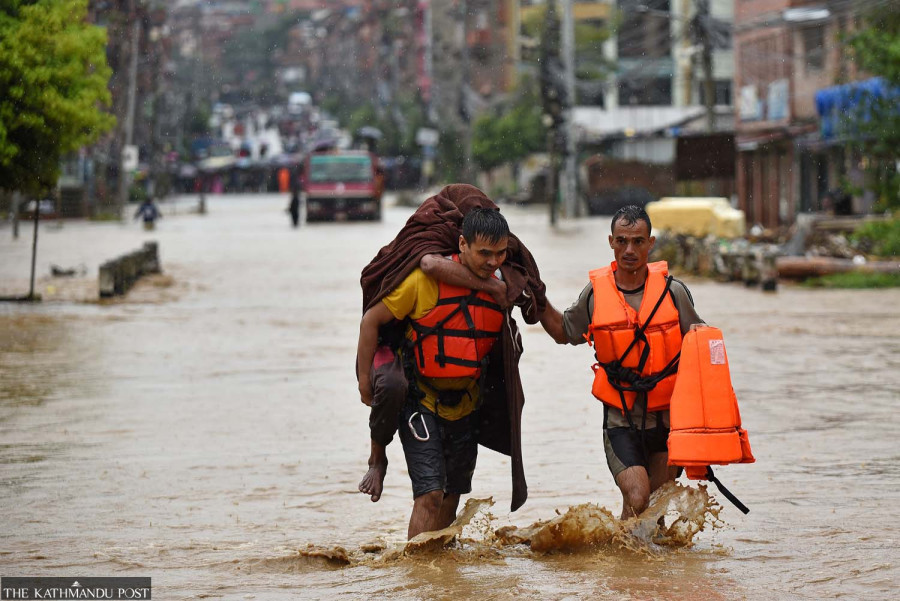Columns
Disaster emergency preparedness and response
Lack of high-tech equipment and effective search and rescue constrains Nepal’s disaster response.
Mina Adhikari
Nepal experiences recurring flood hazards, primarily during the monsoon season, accounting for 10 percent of the total disasters. Flood frequency and severity have increased with erratic and unpredictable rainfall and heightened climate variability. For instance, in 2014, Western Nepal experienced its worst flood event, claiming 222 lives and destroying infrastructure and property. Similarly, the country experienced floods in 35 districts affecting over a million people in 2017, inundating 80 percent of land in Terai. The recent September floods took more than 200 lives, destroying homes, infrastructure and farmlands across the country.
The Government of Nepal and its development partners have implemented mitigation measures such as early warning systems and flood response and preparedness guidelines to reduce the impacts of flood hazards. However, these efforts are inadequate to combat the impending flood risk.
The government must overcome multiple obstacles to achieve effective emergency preparedness and response (EPR). There is a reluctance to adopt risk-informed disaster risk reduction governance, which leaves gaps in translating policies into practice. Nepal has ample policies, laws, guidelines and frameworks that enable EPR, but the implementation is lacking. For instance, the National Disaster Response Framework (NDRF) and standard operating procedures in emergency operation centres (EOCs) guide the EPR activities of stakeholders. Despite this, the absence of effective readiness and response resulted in the loss of lives and damage to property, crops and critical infrastructure in the September 2024 floods.
Nepal’s capability to respond to a major disaster is highly constrained by the lack of high-tech equipment and capacities to run effective search and rescue operations. According to the Emergency Preparedness and Response Assessment 2022-23 report, the government has established emergency operation centres nationwide. Still, most of these are non-functional due to the lack of trained human resources, appropriate equipment, information technology and communication systems. Further, a few disaster information systems such as the Building Information Platform Against Disaster and the disaster risk reduction (DRR) portal exist in the country. However, these systems are weak with limited and scattered information on long-term flood forecasts.
Some local governments are struggling to solve the emergent flood problems in their jurisdiction at the local level as they have limited emergency preparedness and response knowledge and skills. This is a critical obstacle in disaster response planning and policymaking, ultimately weakening the overall disaster management mechanism. Competing interests between the district’s bureaucratic actors and local governments result in a reluctance to cooperate in decision-making for local recovery and response and preparedness needs.
Although new policies and actors demand effective EPR, flood risk reduction efforts are generally focused on response and recovery. For example, the Red Cross, which is the DRR secretariat for the District Administration Office, collaborate with the key federal and local actors with mandate and responsibilities to regulate first responders (Army and APF) for response and relief operation. These actors effectively respond and recover but have limited expertise in disaster risk reduction and resilience building in vulnerable communities.
Damage and loss in flood-prone areas are frequently linked to a lack of community knowledge and preparedness for flood risk. Several initiatives are in place to raise community awareness, including awareness campaigns, training, school disaster curriculum, TV broadcasts and installation of early warning systems. However, such information-based approaches are futile as they only disseminate the content one way and often treat the public as passive consumers. According to research, information dissemination is ineffective in closing the knowledge gap or encouraging behavioural change. The role of individuals in response to flood risk is vital while developing effective flood preparedness.
Moreover, inadequate financial readiness involving low budget allotments and dependence on external funding sources for disaster risk reduction is also hampering effective emergency preparedness and response. Pathways to strengthen it include promoting risk-informed DRR governance, increasing investment in DRR and community resilience and building capacity to change the mindset of stakeholders and communities.
Risk-informed governance involves understanding multi-hazard threats, making risk-based decisions, integrating DRR strategies in development, and investing in mitigation and preparedness for effective management and recovery at all levels. Preparing and implementing localised national Disaster Risk Reduction and Management strategic action plans, multi-hazard risk assessment tools and methodologies, risk-informed development plans and investment decisions is necessary. We must increase investment in DRR and community resilience focusing on innovative and sustainable financing mechanisms such as public-private-people partnerships and forecast-based financing to strengthen disaster risk governance and community resilience. Only by changing the mindsets of stakeholders and communities can we strengthen risk-informed governance.
Nepal’s disaster emergency preparedness and response need serious attention from the government, communities and individuals. Their concerted efforts in implementing a proactive and risk-informed approach can significantly improve preparedness and response capabilities. This will ultimately safeguard lives, property and livelihoods from the devastating impacts of floods.




 19.12°C Kathmandu
19.12°C Kathmandu















